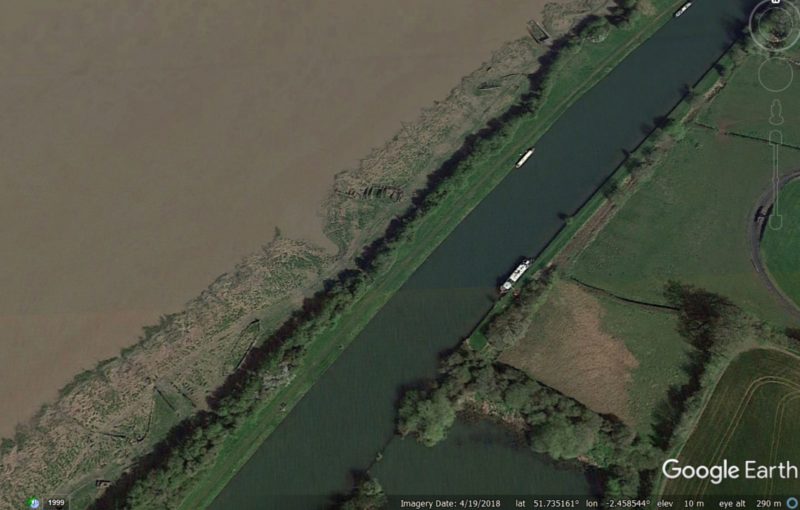20 March 2020
Sinking ships to stop erosion
Posted by Dave Petley
Sinking ships to stop erosion
A wide range of approaches have been developed to try to reduce or stop erosion and landslides, with mixed success and (in some cases) no lack of controversy. Gloucestershire Live has published a nice article about an approach that is new to me, but provided to be surprisingly successful. Along the banks of the River Severn, in southwest England, ships were sunk to protect the riverbanks and to stop erosion. This was undertaken in a number of locations, but one such spot lies at Purton (located at 51.736, -2.457), and is visible on Google Earth:-

Sinking ships to stop erosion: Google Earth imagery of the Purton ships graveyard. The ships are buried in the banks between the River Severn to the north and the canal to the south.
.
There is a similar situation at Wainlodes (location 51.930, -2.224).
This is what the ships look like on the ground:-

Sinking ships to stop erosion: the Purton ships graveyard. Image via Gloucestershire Live.
The Gloucestershire Live article explains the rationale:-
In the case of Wainlodes an ancient crossing point on the river, the barges were sunk just after the First World War to slow the stream that was eating away at the hill causing regular landslips.
At Purton the need to arrest erosion was much more pressing. In about 1910 the Severn changed its course. Serious and rapid erosion of the bank took place that threatened to break through to the Sharpness to Gloucester Ship Canal, which was a busy commercial waterway bringing timber, grain, oil and other commodities to Gloucester Docks from all over the world. Action had to be taken quickly.
The canal authority bought the hulks of vessels that were at the end of their working life from the owners to use as breakwaters. Tugs took the hulks at full tilt to the place where they were to be beached, then cast off and let them run aground, leaving the man at the tiller marooned. He had to hole the hulk, then be taken off.
It was a remedy that worked. The hulks, also known as wingdykes, slowed the velocity of the river, which then deposited sediment around the wrecks. This reduced the stream further, which meant that more silt was deposited and so the cycle continued until today many of the craft that were beached decades ago now stand on dry, reclaimed land.
Once the plan was proven to work, more vessels were beached. In 1945 there were nine of them, by about 1952 there were 21 and then more were grounded in the 1960s.
This is an unusual but seemingly highly effective way to stop erosion and thus to prevent landslides. Erosion of riverbanks is proving to be a substantial problem in many parts of the world at the moment; novel approaches may be needed elsewhere too.


 Dave Petley is the Vice-Chancellor of the University of Hull in the United Kingdom. His blog provides commentary and analysis of landslide events occurring worldwide, including the landslides themselves, latest research, and conferences and meetings.
Dave Petley is the Vice-Chancellor of the University of Hull in the United Kingdom. His blog provides commentary and analysis of landslide events occurring worldwide, including the landslides themselves, latest research, and conferences and meetings.
Similar problems here in Edmonton Canada: See if you can spot the crowns –
https://www.google.com/maps/place/River+Valley+Rd+NW,+Edmonton,+AB,+Canada/@53.4945549,-113.5840768,2842m/data=!3m1!1e3!4m5!3m4!1s0x53a0222454fa1983:0xf11f01af9dd1a32c!8m2!3d53.5324357!4d-113.5200694
Que buena idea, sera que las aspas de los generadores eólicos podrían aprovecharse en zonas con erosión costera o fluvial.
Must wonder what future archaeologists will make of them !!
😉